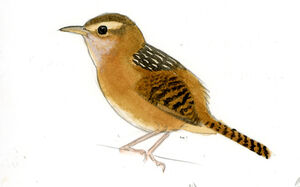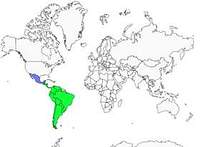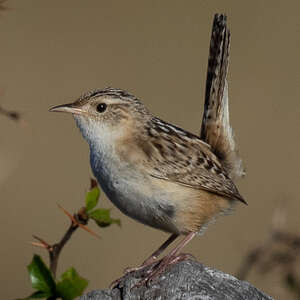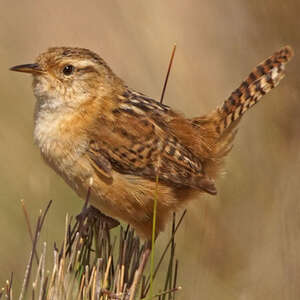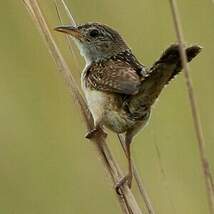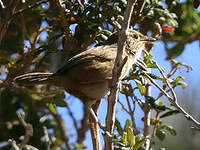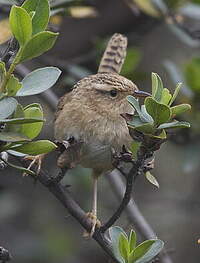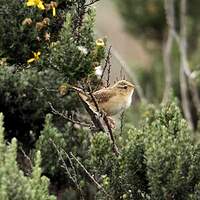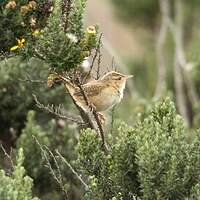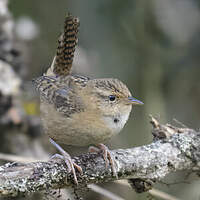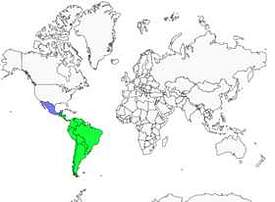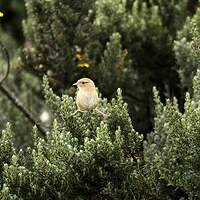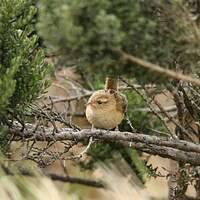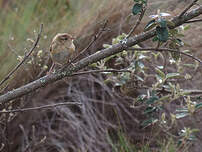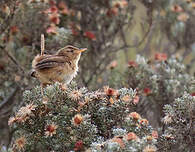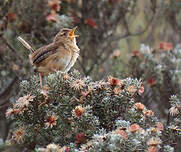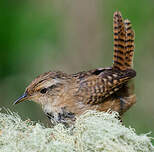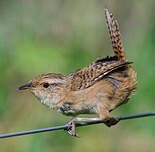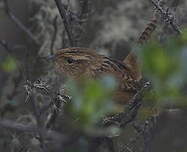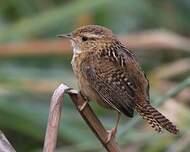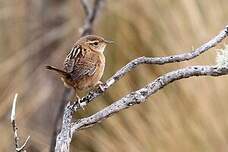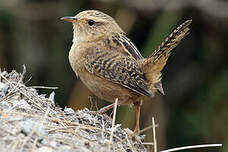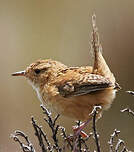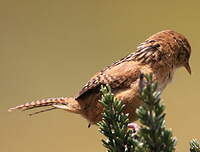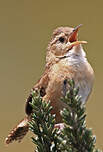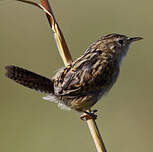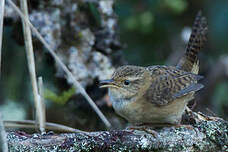Grass Wren
Cistothorus platensis - Troglodyte de Latham
Identification
Currently, 17 subspecies of the Grass Wren, C. platensis, are recognized. A recent one, ssp stellaris, was recently raised to the species level, the Short-billed Grass Wren, C. stellaris. The 17 subspecies differ only in measurement details and significant variations in the background color of the plumage, which is more or less warm. Here we will describe the nominal subspecies, platensis, from Argentina (photo 1).
Males and females are identical. The adult is chamois-fawn on the back and white on the underside. The mantle is heavily striped black and white, while the scapulars and wing coverts are brown. As is typical of the Troglodytidae, the remiges and rectrices are distinctly barred brown. The upperscapes are tinged rusty. The throat and breast are off-white, turning light brown on the belly, while the flanks and lower belly are bright brown. The underscapes are creamy.
On the head, the beige crown is finely striped with black and white, edged by a chamois eyebrow fading into the same color lores. The cheeks are slightly streaked, and the eye is dark. The slightly curved beak is dark brown with the base of the lower mandible being horn-coloured. The legs are pinkish.
The juvenile looks like the adult but the white stripes on the back are less visible and it is paler underneath.
Subspecific information 17 subspecies
- Cistothorus platensis platensis (c and e Argentina)
- Cistothorus platensis tinnulus (w Mexico)
- Cistothorus platensis potosinus (San Luis Potosí. c Mexico.)
- Cistothorus platensis jalapensis (c Veracruz. e Mexico.)
- Cistothorus platensis warneri (lowlands of Veracruz, Tabasco and Chiapas. se Mexico.)
- Cistothorus platensis russelli (Belize)
- Cistothorus platensis elegans (s Mexico and Guatemala)
- Cistothorus platensis graberi (se Honduras and ne Nicaragua)
- Cistothorus platensis lucidus (Costa Rica and w Panama)
- Cistothorus platensis alticola (n Colombia through Venezuela to w Guyana)
- Cistothorus platensis aequatorialis (wc Colombia to c Peru)
- Cistothorus platensis graminicola (sc Peru)
- Cistothorus platensis minimus (s Peru to s Bolivia)
- Cistothorus platensis polyglottus (se Brazil, Paraguay and ne Argentina)
- Cistothorus platensis tucumanus (s Bolivia and nw Argentina)
- Cistothorus platensis hornensis (c and s Chile, s Argentina)
- Cistothorus platensis falklandicus (Falkland Is.)
Foreign names
- Troglodyte de Latham,
- Cucarachero sabanero,
- corruíra-do-campo,
- Pampazaunkönig,
- Graswinterkoning,
- Scricciolo pagliarolo,
- gräsgärdsmyg,
- Sivsmett,
- oriešok bahenný,
- střízlík ostřicový,
- Kortnæbbet Græssmutte,
- sarapeukaloinen,
- cargolet de planura,
- strzyżyk nadrzeczny,
- grīšļu ceplītis,
- Травяной короткоклювый крапивник,
- コバシヌマミソサザイ,
- 短嘴沼泽鹪鹩,
- gräsgärdsmyg,
- 短嘴沼澤鷦鷯,
Voice song and call
The song consists of liquid notes in staccato, rolls, trills, but also stretched syllables with a slightly grating sound, all of which is quite pleasant to the ear. There is great variability in the song depending on the different subspecies. The call is a sharp tac or a softer tep.
Habitat
The species inhabits a variety of grassy habitats, from sea level to 4000m depending on the country. This ranges from dry savannah to wet and floodable habitats. In Colombia and Ecuador, they can be spotted in the high altitude paramo. In Brazil, they reside in the dry savannahs of the Cerrado. In Argentina, they live in the margins of tidal marshlands, influenced by the tides. On the Falkland Islands, they can be observed in the meadows.
Behaviour character trait
Dietfeeding habits
This species feeds low in the herbaceous stratum. Its diet is essentially insectivorous in a broad sense. Prey is often large relative to the size of the bird, such as orthopterans. Seed of herbaceous plants complements the diet, particularly in the unfavorable season when one exists. Birds of the ssp. hornensis have been observed in Tierra del Fuego while they were feeding on insects and seeds on the ground still covered with snow.
Reproduction nesting
Given that the species nests from Mexico to Tierra del Fuego, the breeding season obviously varies from north to south and, depending on the latitude, there is only one or two successive nests.
For example, in the Equator, young ones are seen flying in January and May while in the Falkland Islands, nest building occurs from October to December.The nest, 10 cm high, is globular with a lateral entrance. It is made of intertwined grasses and the support. The male builds a handful of them, up to 10. The choice of which one will serve for reproduction is up to the female. She finishes it off by lining the interior with fine vegetable matter and feathers. On average, 4-5 white eggs are laid and incubated by the female for a full 15 days. The young will be fed at the nest by the couple for another 15 days before being able to leave the nest.
The reproductive success is often low, for example 26% in an Argentine study. This study also shows that 77% of females who have nested successfully take on a second nest and that almost 1 in 3 nests is parasitized by the Grass Wren.
Geographic range
The Grass Wren is distributed across Central and South America, from Aguascalientes in central-southern Mexico to Tierra del Fuego in Argentina, mainly following the Andes mountain range. It is rare in the east and absent in a large part of Brazil, as well as the Falkland Islands. The 17 subspecies have the following distributions:
* C. p. potosinus - Central-southern Mexico (San Luis Potosí).
* C. p. tinnulus - Western Mexico (Nayarit, Michoacán, México and Federal District).
* C. p. jalapensis - Eastern Mexico (central Veracruz).
* C. p. warneri - South-eastern Mexico (lower Veracruz, Tabasco and Chiapas).
* C. p. russelli - Belize (Toledo and Cayo Districts).
* C. p. elegans - Mountain ranges of southern Mexico (from Veracruz) and Guatemala.
* C. p. graberi - South-eastern Honduras and north-eastern Nicaragua.
* C. p. lucidus - Costa Rica and western Panama.
* C. p. alticola - From northern Colombia to western Guyana, via Venezuela.
* C. p. tolimae - Northern parts of the Colombian Andes (Caldas, Tolima).
* C. p. aequatorialis - Colombian Andes to central Peru (Junín).
* C. p. tamae - South-western Venezuela (south Táchira) and eastern Colombia.
* C. p. graminicola - Central-southern Peru (Junín, Cuzco).
* C. p. minimus - From southern Peru to southern Bolivia.
* C. p. tucumanus - From southern Bolivia to north-western Argentina (Jujuy, Catamarca and Tucumán).
* C. p. polyglottus - South-eastern Brazil, Paraguay and north-eastern Argentina.
* C. p. platensis - Central and eastern Argentina (eastern Córdoba and Mendoza).
* C. p. hornensis - Central and southern Chile and southern Argentina up to Cape Horn.
* C. p. falklandicus - Falkland Islands (Falklands).
Threats - protection
IUCN conservation status
concern
in the Wild
threatened
evaluated
This species is not generally threatened and is actually quite common. However, there is not much data available to assess its exact status. Due to its nomadic nature, it is quite challenging to record. It would appear to be locally increasing due to deforestation.
Sources of information
- IOC World Bird List (v15.1), Gill, F and D Donsker (Eds). 2025-12-07.
- All the Birds of North America, American Bird conservancy's Field Guide
- Birds of Venezuela, Steven L. Hilty
- Birds of Mexico Central America, Ber Van Perlo
- Canada's Aquatic Environments,
- ARKive, Christopher Parsons
- Avibase, Lepage Denis
- HBW Alive,
- Birds of Nova Scotia, Robie Tufts
Other sources of interest
 Specification sheet created on
28/07/2023 by Jean François
Specification sheet created on
28/07/2023 by Jean FrançoisTranslation by AI Oiseaux.net
© 1996-2025 Oiseaux.net
- Accipitriformes
- Aegotheliformes
- Anseriformes
- Apodiformes
- Apterygiformes
- Bucerotiformes
- Caprimulgiformes
- Cariamiformes
- Casuariiformes
- Charadriiformes
- Ciconiiformes
- Coliiformes
- Columbiformes
- Coraciiformes
- Cuculiformes
- Eurypygiformes
- Falconiformes
- Galliformes
- Gaviiformes
- Gruiformes
- Leptosomiformes
- Mesitornithiformes
- Musophagiformes
- Nyctibiiformes
- Opisthocomiformes
- Otidiformes
- Passeriformes
- Pelecaniformes
- Phaethontiformes
- Phoenicopteriformes
- Piciformes
- Podargiformes
- Podicipediformes
- Procellariiformes
- Psittaciformes
- Pterocliformes
- Rheiformes
- Sphenisciformes
- Steatornithiformes
- Strigiformes
- Struthioniformes
- Suliformes
- Tinamiformes
- Trogoniformes

